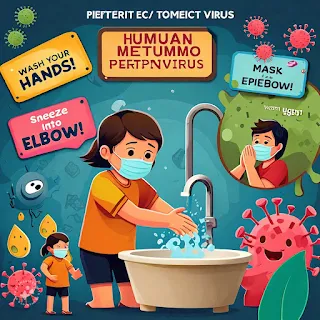Understanding Human Metapneumovirus (HMPV): Symptoms, Prevention, and Precautions
Introduction
Human Metapneumovirus (#HMPV) is a seasonal respiratory virus that mainly affects children and the elderly during colder months. Although it generally causes mild symptoms, it can sometimes lead to severe respiratory complications. Recently, there has been an increase in HMPV cases in China, but the situation in India remains controlled with only a few reported cases. This article explores HMPV, its symptoms, preventive measures, and the importance of awareness in public health.
#HMPV in India and the Global Scenario
The Indian Council of Medical Research (ICMR) has reported two cases of HMPV detected in Karnataka through routine surveillance. While this is not alarming, it highlights the need for constant monitoring. The situation in China, however, has raised concerns, with some uncertainty regarding whether the country is dealing with a new strain or a regular seasonal outbreak.
What is Human Metapneumovirus?
HMPV, first identified in 2001, belongs to the Paramyxoviridae family and is closely related to Respiratory Syncytial Virus (RSV). It commonly spreads during the winter months, with a peak transmission period between July and January in some regions. While HMPV can affect people of all ages, it poses a higher risk to infants, older adults, and those with compromised immune systems.
Symptoms of HMPV
The symptoms of HMPV are similar to those of a cold or flu, which can make it challenging to distinguish from other respiratory illnesses. Common symptoms include:
- Cough
- Runny or blocked nose
- Fever
- Sore throat
- Shortness of breath (in severe cases)
In rare cases, HMPV can progress to more serious conditions like pneumonia or bronchiolitis, which may require medical intervention, such as oxygen therapy or mechanical ventilation.
How Does HMPV Spread?
HMPV spreads primarily through respiratory droplets when an infected person coughs or sneezes. The virus can also spread by:
- Touching contaminated surfaces and then touching the face
- Close contact in crowded areas, such as public transportation and schools
The virus is highly contagious, especially during peak seasons, making preventive measures essential.
Preventive Measures Against HMPV
Although there is no specific antiviral treatment or vaccine for HMPV, several measures can help reduce the risk of infection:
-
Maintain Proper Hygiene
- Wash hands regularly with soap and water for at least 20 seconds.
- Use hand sanitizers with at least 60% alcohol when soap is unavailable.
-
Practice Good Cough and Sneeze Etiquette
- Cover your mouth and nose with a tissue or elbow when coughing or sneezing.
- Dispose of tissues immediately and wash hands afterward.
-
Wear Masks When Necessary
- Use masks in crowded or high-risk areas, especially during the peak respiratory virus season.
-
Avoid Sending Sick Children to School
- Keep children home if they show symptoms like fever, cough, or a runny nose to prevent spreading the virus to others.
-
Boost Immunity
- Maintain a balanced diet with plenty of fruits, vegetables, and fluids.
- Ensure adequate sleep and engage in regular physical activity to enhance immunity.
When to Seek Medical Attention
While most cases of HMPV resolve with basic care, it's important to seek medical attention if the following warning signs occur:
- Persistent high fever
- Difficulty breathing
- Bluish color around the lips or face
- Extreme fatigue or confusion
Conclusion
Human Metapneumovirus is a seasonal virus that requires attention, not panic. By adopting proper hygiene, maintaining good respiratory etiquette, and staying home when sick, we can significantly reduce the spread of the virus. While most cases are mild and self-limiting, staying informed and cautious—especially during peak respiratory season—is key to managing this and other respiratory illnesses.
By being proactive and following health guidelines, we can effectively manage HMPV and protect ourselves and our communities from unnecessary outbreaks.
Disclaimer: This article is for informational purposes only and does not replace professional medical advice. Always consult a healthcare provider for personalized guidance.




Comments
Post a Comment